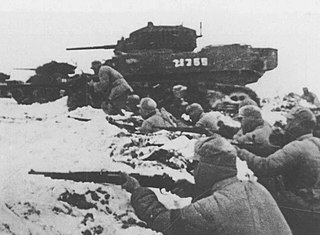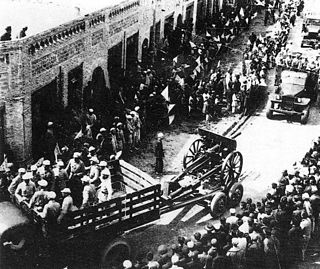The Zhengtai Campaign (正太战役) was a series of battles fought between the nationalists and the communists during the Chinese Civil War in the post World War II era, and resulted in the communist victory.
The Summer Offensive of 1947 in Northeast China (东北1947年夏季攻势) is a series of battles initiated by the communists against the nationalists during the Chinese Civil War after World War II.
The Linfen–Fushan Campaign (临浮战役) was a series of battles fought in regions between Linfen and Floating Mountain in Shanxi, China between the nationalists and the communists during the Chinese Civil War and resulted in communist victory.
Campaign to the North of Baoding consisted of several battles fought between the Nationalists and the Communists in the region north of Baoding during the Chinese Civil War in the post-World War II era and resulted in a Communist victory.
The Yanzhou campaign, also known as the campaign at the central section of the Tianjin-Pukou Railway, was a series of battles fought between the nationalists and the communists for the control of the town Yanzhou, which is today under the administration of Jining, and the region to the north of the town in Shandong, China during the Chinese Civil War in the post World War II era, and resulted in communist victory.
The Hebei – Rehe – Chahar Campaign (冀热察战役) was a series of battles fought in Northern China between the nationalists and the communists during the Chinese Civil War in the post World War II era, and resulted in communist victory.
Lüliang campaign (吕梁战役), also called Southwestern Shanxi campaign (晋西南战役), was a series of battles fought between the nationalists and the communists in Lüliang region in southwestern Shanxi during the Chinese Civil War in the post World War II era, and resulted in the communist victory.
Campaign along the Southern Section of the Datong-Puzhou Railway (同蒲路南段战役) was a campaign fought between the nationalists and the communists during the Chinese Civil War in the post-World War II era and resulted in the communist victory.
Datong-Jining Campaign (大同集宁战役) was a series of battles fought between the nationalists and the communists mainly in northern Shanxi and the surrounding regions during the Chinese Civil War in the post-World War II era. The main battlefield was centered on two cities, Datong and Jining.
The Campaign to the North of Daqing River was a series of battles fought between the nationalists and the communists in Hebei, China during the Chinese Civil War in the post-World War II era.
The Battle of Niangziguan was fought between the communists and the nationalists during the Chinese Civil War in the post World War II era and resulted in communist victory. The battle was a critical one in Zhengtai Campaign that helped to determine the outcome of the campaign.
The Battle of Rugao-Huangqiao took place between the communists and the nationalists during the Chinese Civil War in the post World War II era and resulted in communist victory. The battle was one of seven major battles in the Central Jiangsu Campaign.

The Battle of Shuangduiji (双堆集战役) was a major campaign fought between the nationalists and the communists during the Chinese Civil War in the post-World War II era, resulting in a communist victory. The campaign was part of the Huaihai campaign.
Gaoyou–Shaobo campaign was a campaign fought at the Gaoyou and the region between Gaoyou and Shaobo (邵伯) in Jiangsu, and it was a clash between the communists and the former nationalists turned Japanese puppet regime force who rejoined the nationalists after World War II, and their Japanese ally. The campaign is also known as Gaoyou campaign (高邮战役) for short, and it was one of the Chinese Civil War in the immediate post World War II era resulted in communist victory.
The Battle of Yongjiazhen (雍家镇战斗) was fought during the aftermath of World War II in the Yongjiazhen (雍家镇) region of central Anhui, China between Communist forces and Kuomintang forces who had allied with the Japanese. The battle was part of the Chinese Civil War, resulting in a victory for the People's Liberation Army.
Datong–Puzhou campaign (同蒲战役) was a campaign that communists fought against the nationalist during the Chinese Civil War in the post-World War II era in Shanxi, and resulted in communist victory.
Battle of Shangcai was a series of clashes fought between the nationalists and the communists during Chinese Civil War in the post World War II era, and resulted in the communist victory. The battle is also called the Blockade at Shangcai by the communists, who launched the battle to support their Eastern Hennan Campaign, with intention to prevent the nationalist force from reinforcing their comrades fighting the Eastern Hennan Campaign.
Western Tai'an Campaign was a series of battles fought between the nationalists and the communists during Chinese Civil War in the post World War II era, and resulted in the communist victory. The communists also refer this campaign as Campaign to Move Eastward, and viewed this campaign as the prelude to Huaihai Campaign.
The Houma Campaign (侯马战役) or Houma Counteroffensive (侯马反击战) was a series of battles fought between the nationalists and the communists during Chinese Civil War in the post World War II era, and resulted in the communist victory.

The Ningxia Campaign was a series of battles fought between the Nationalists and the Communists during the final months of the Chinese Civil War. It resulted in a Communist victory.



